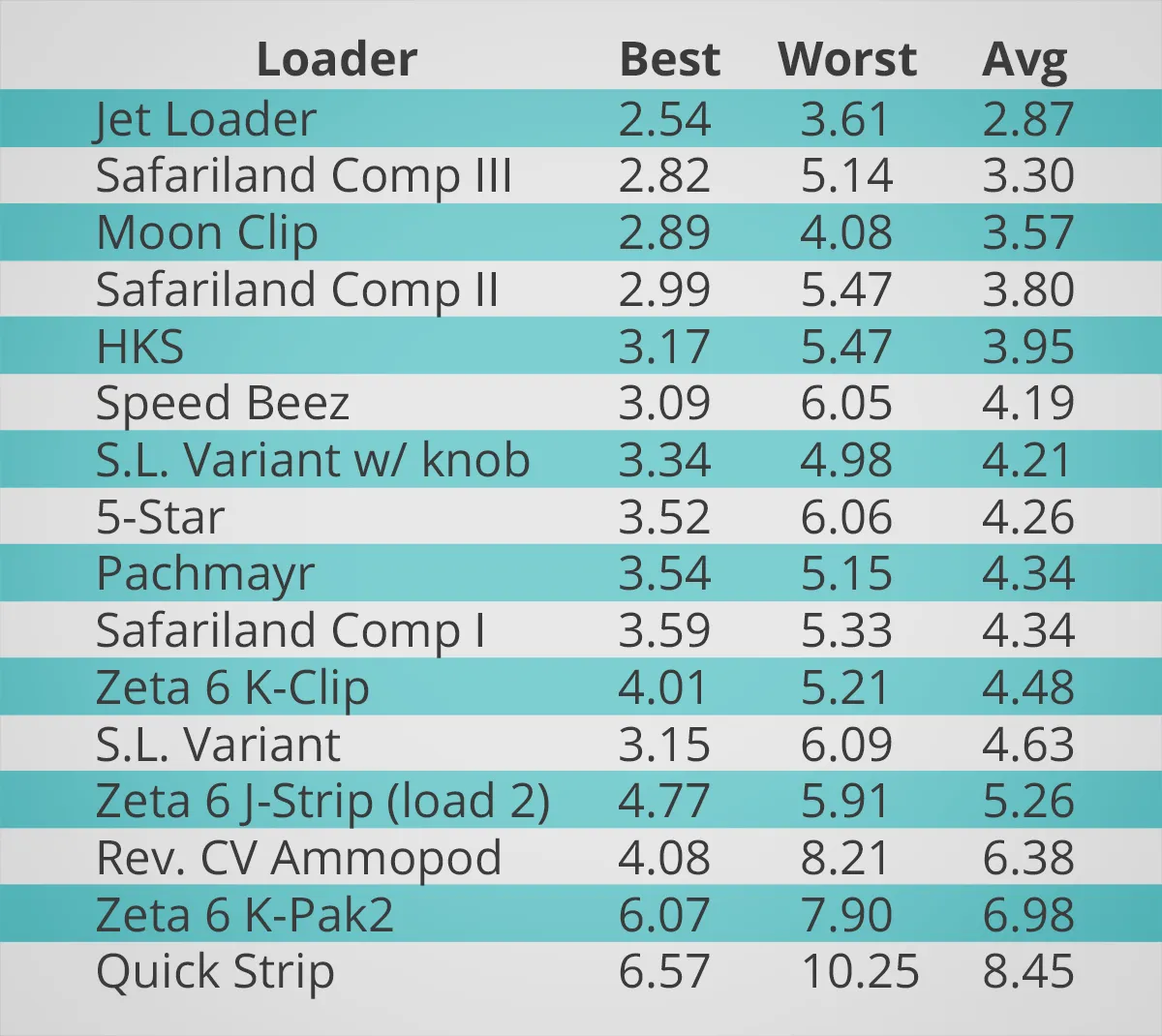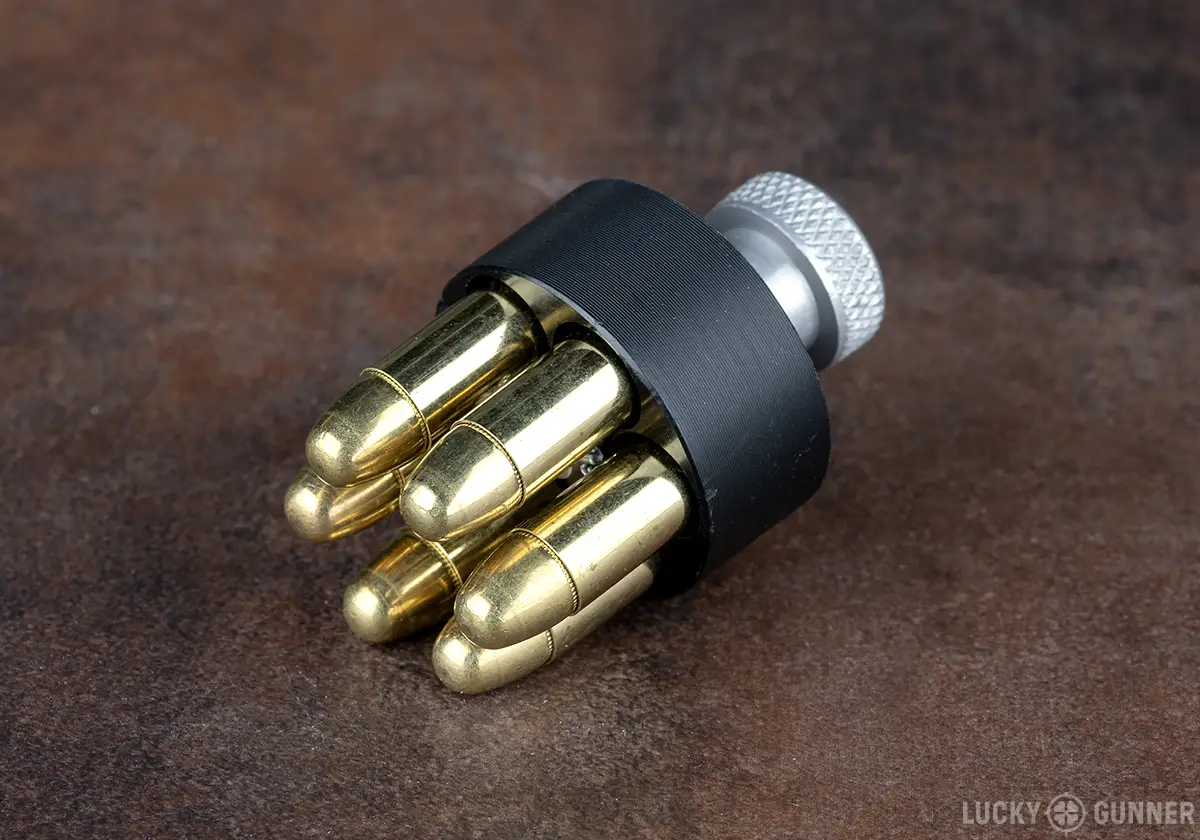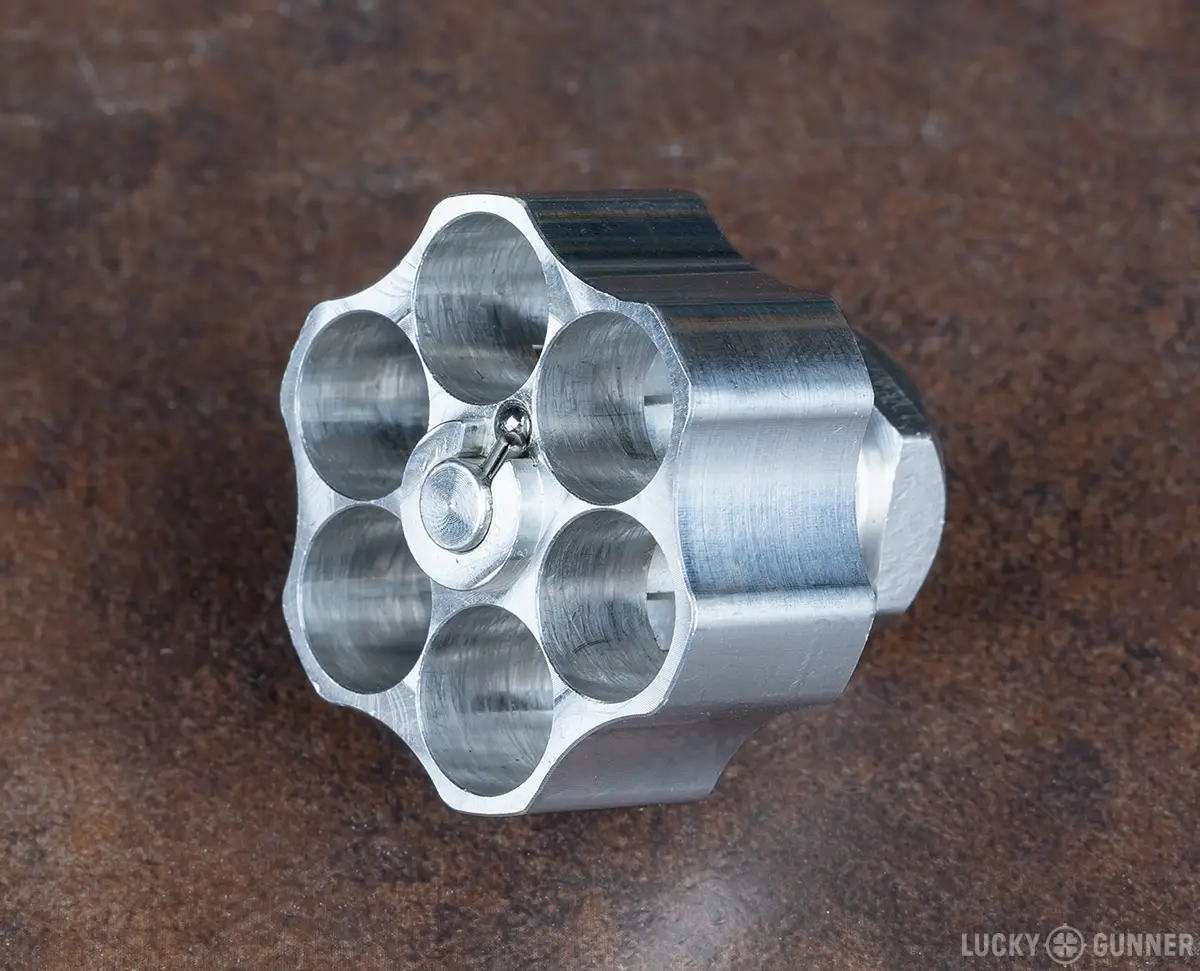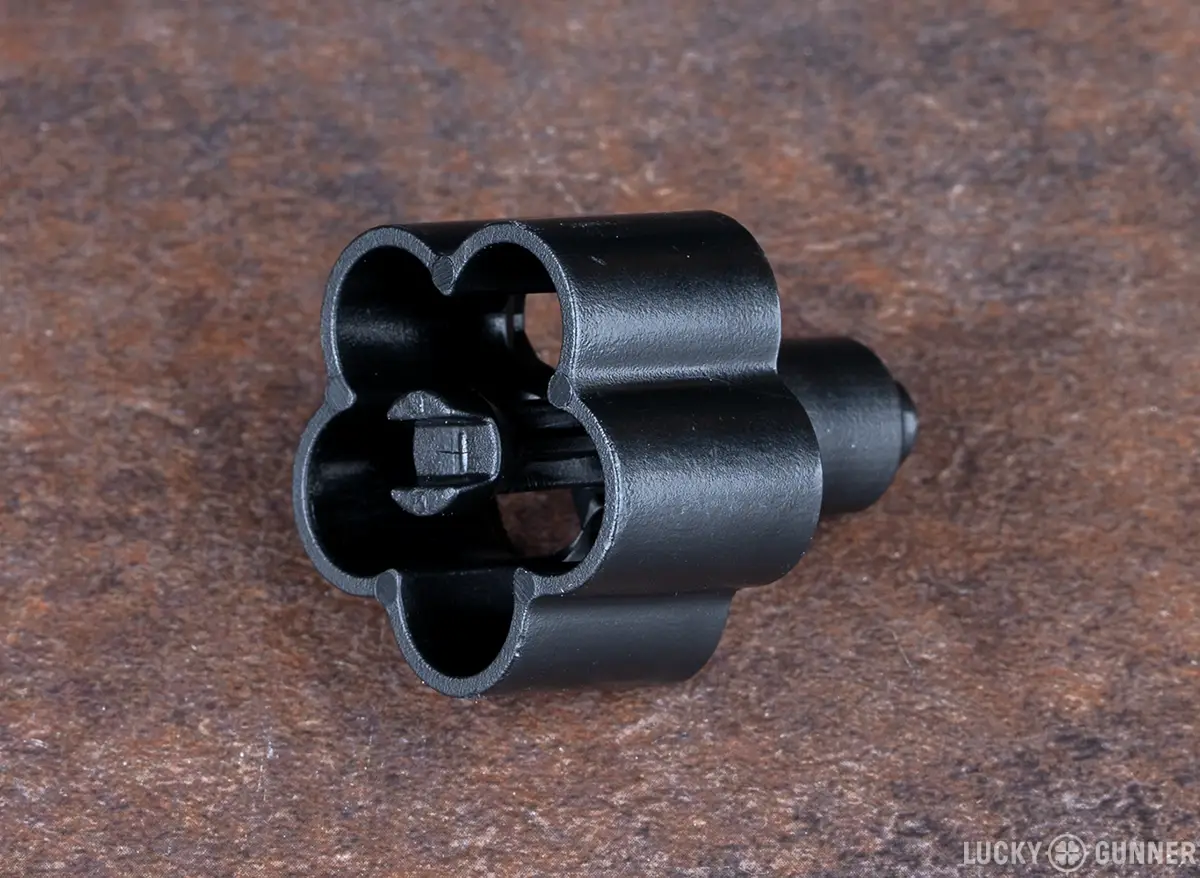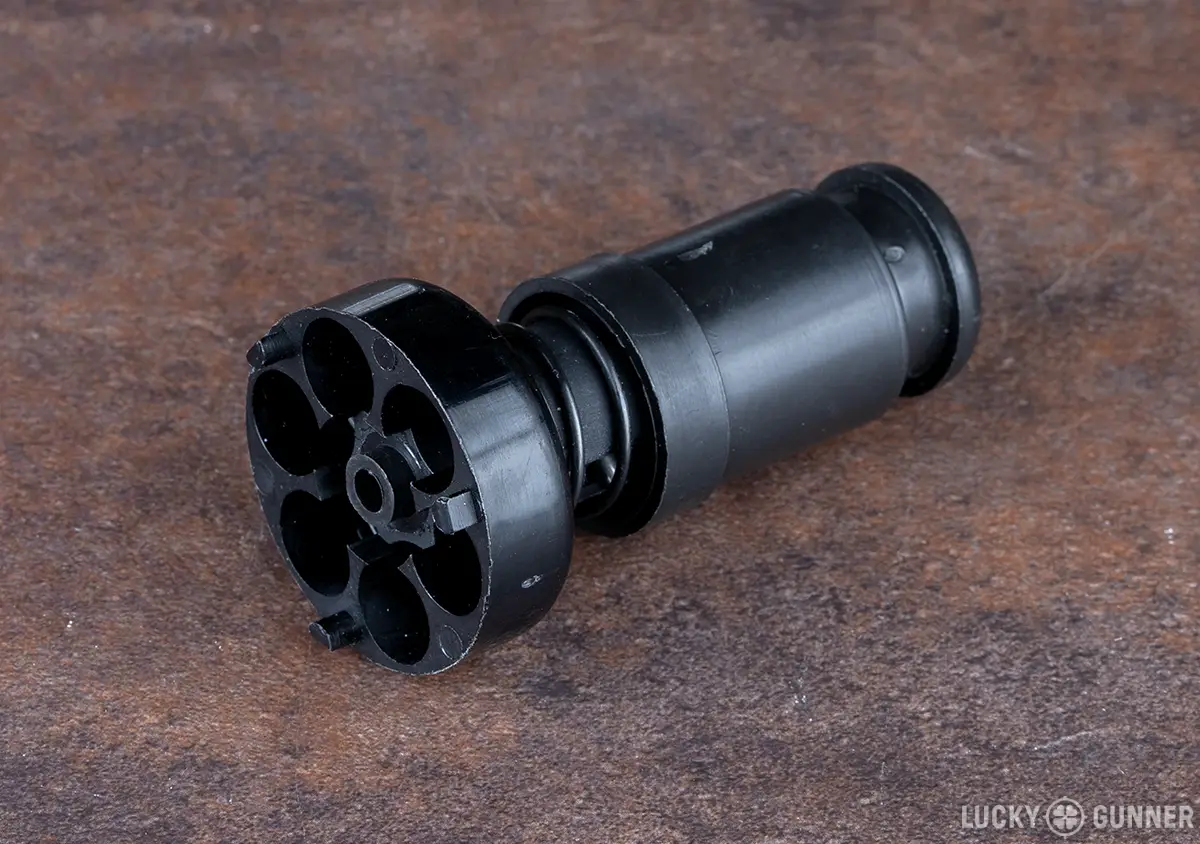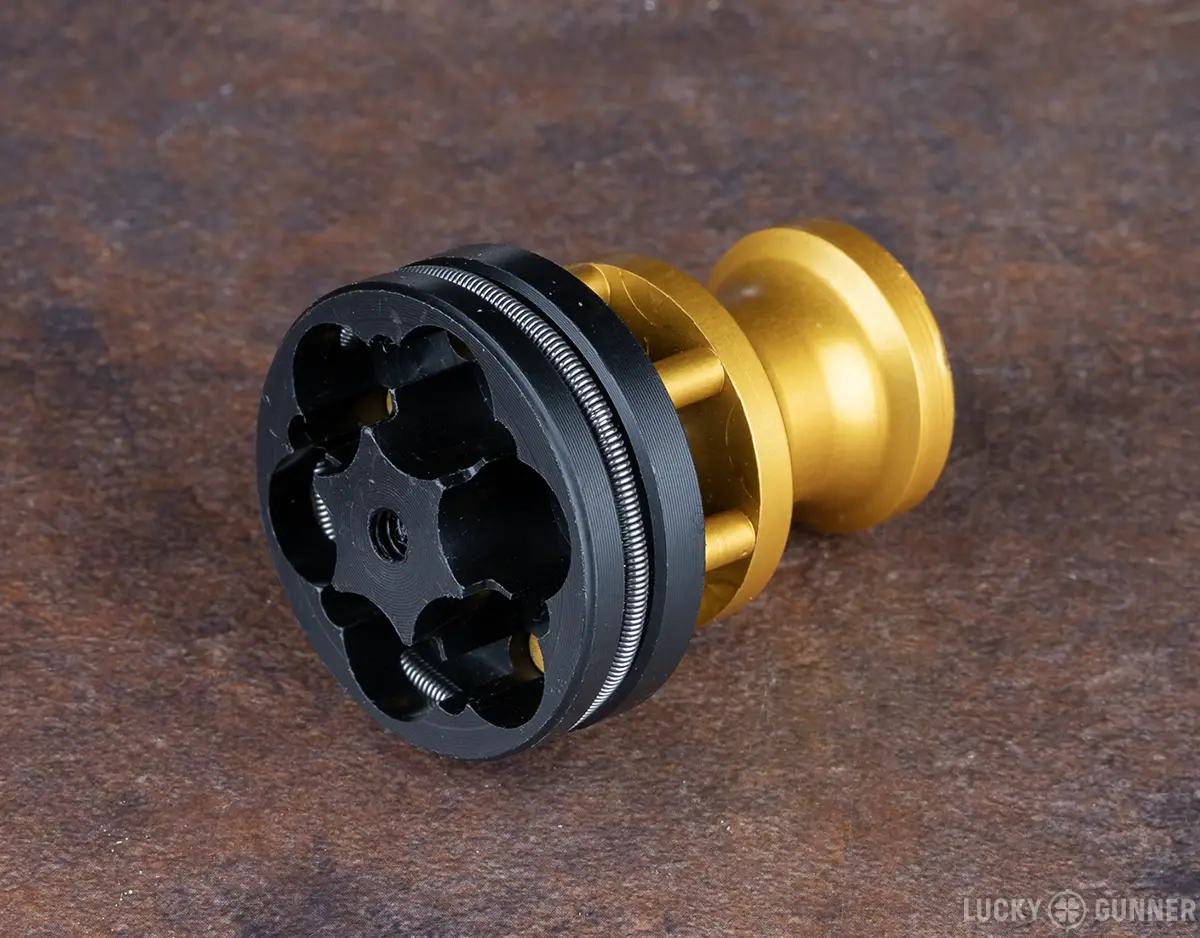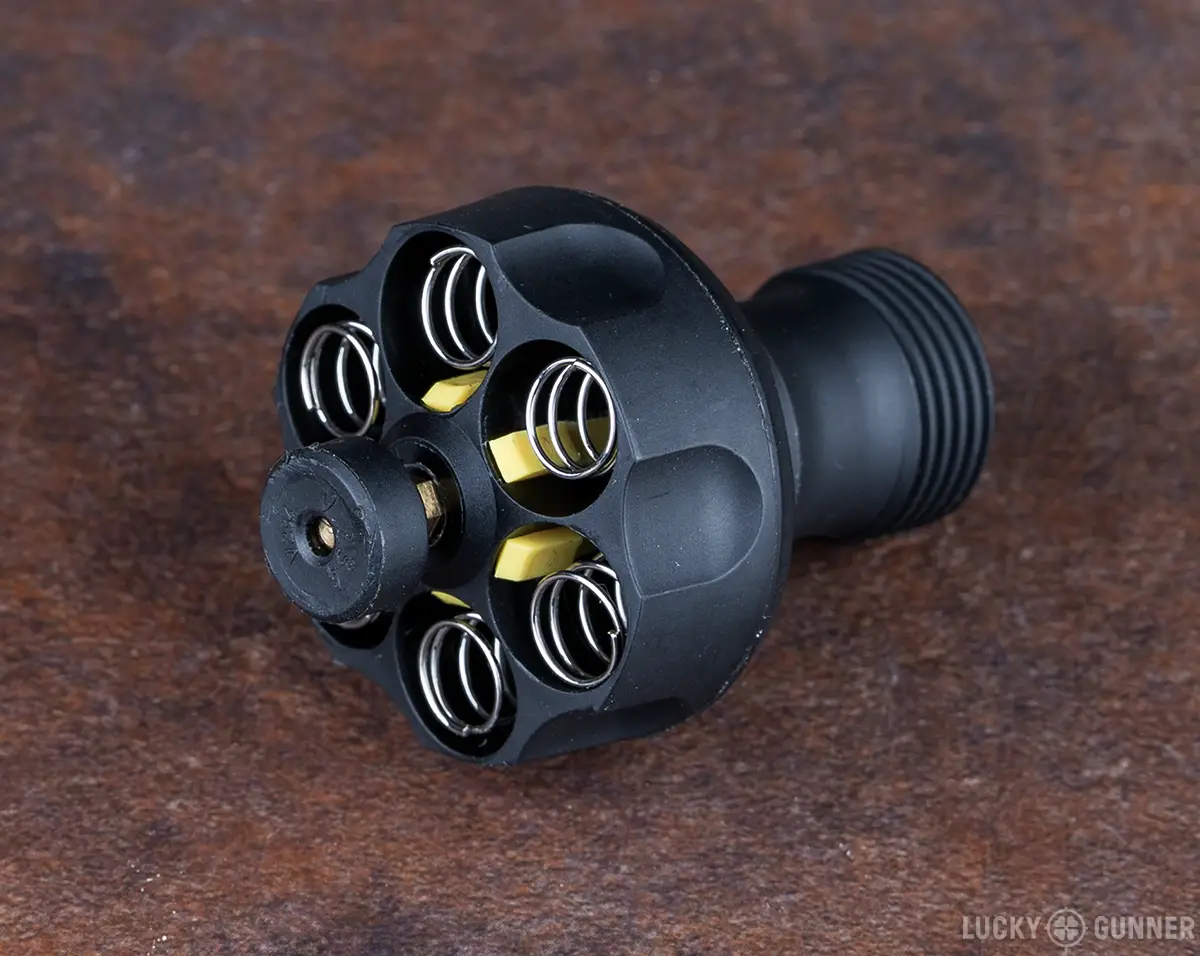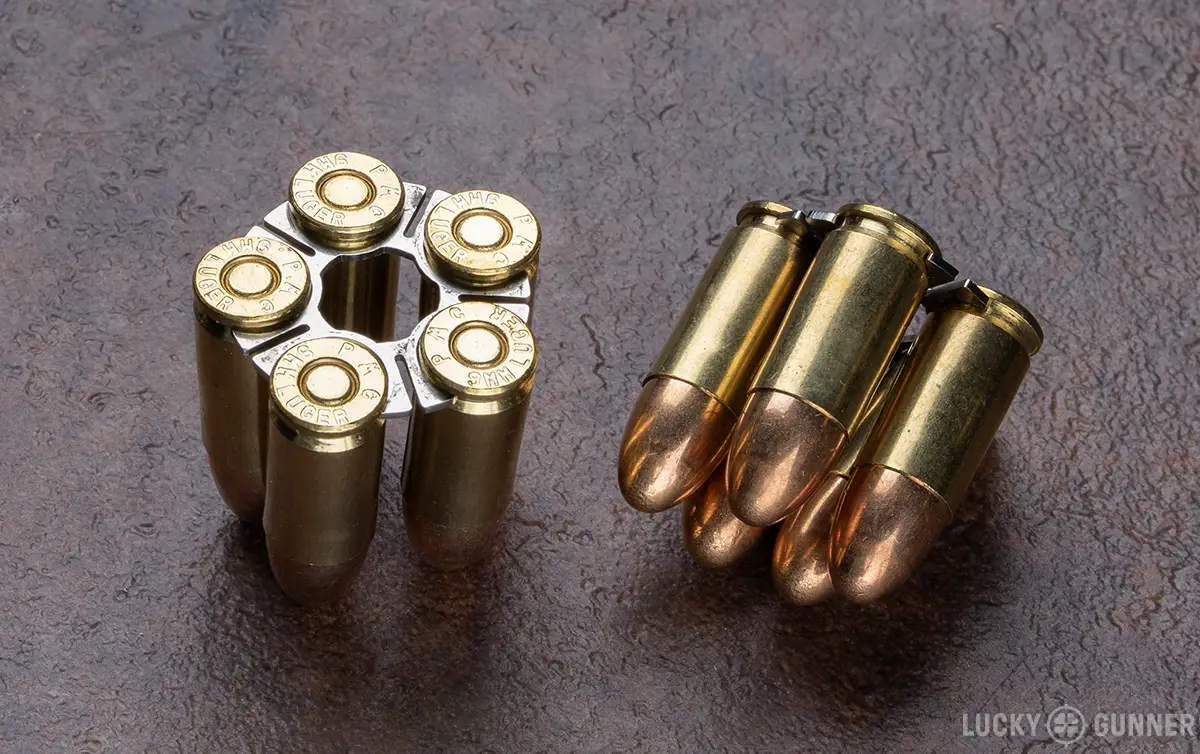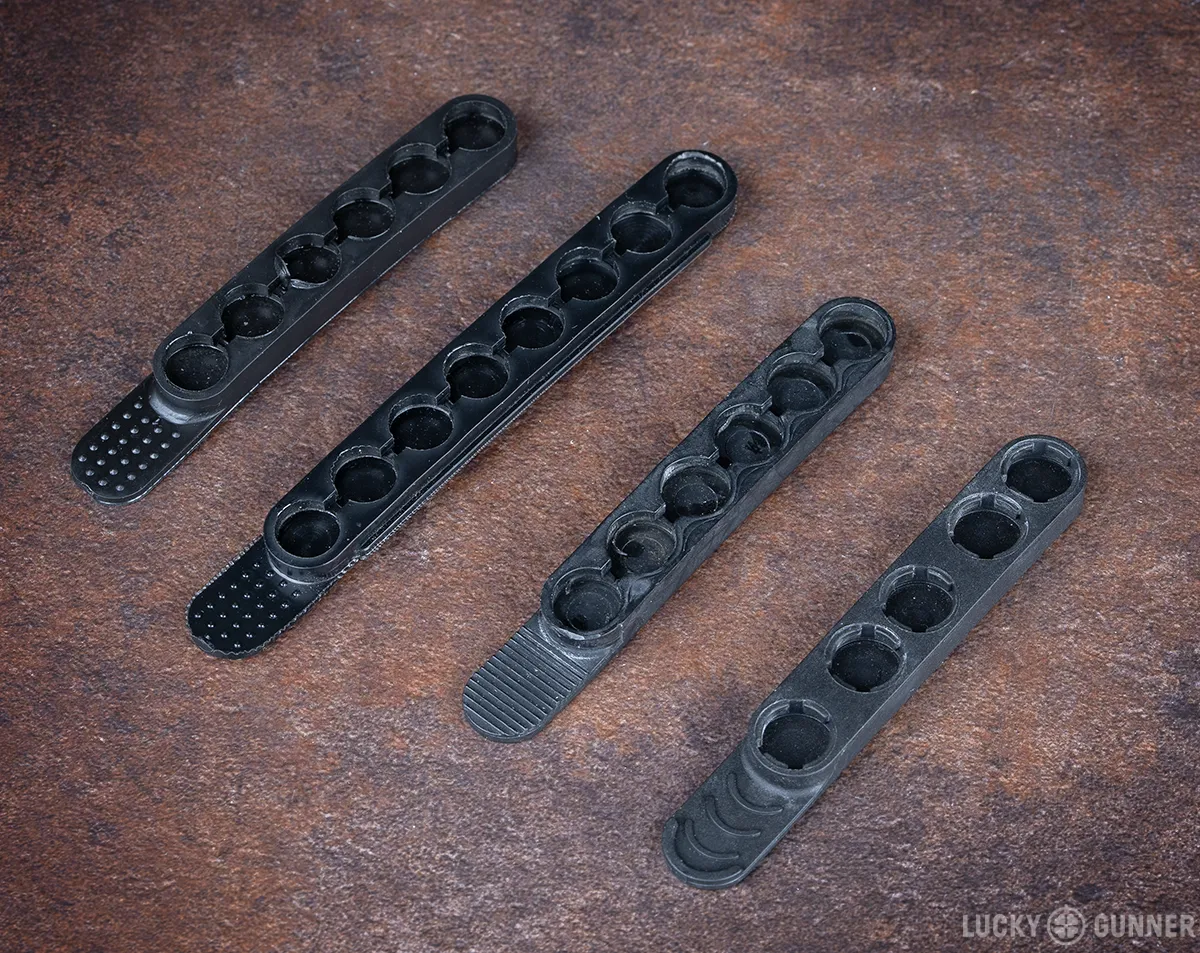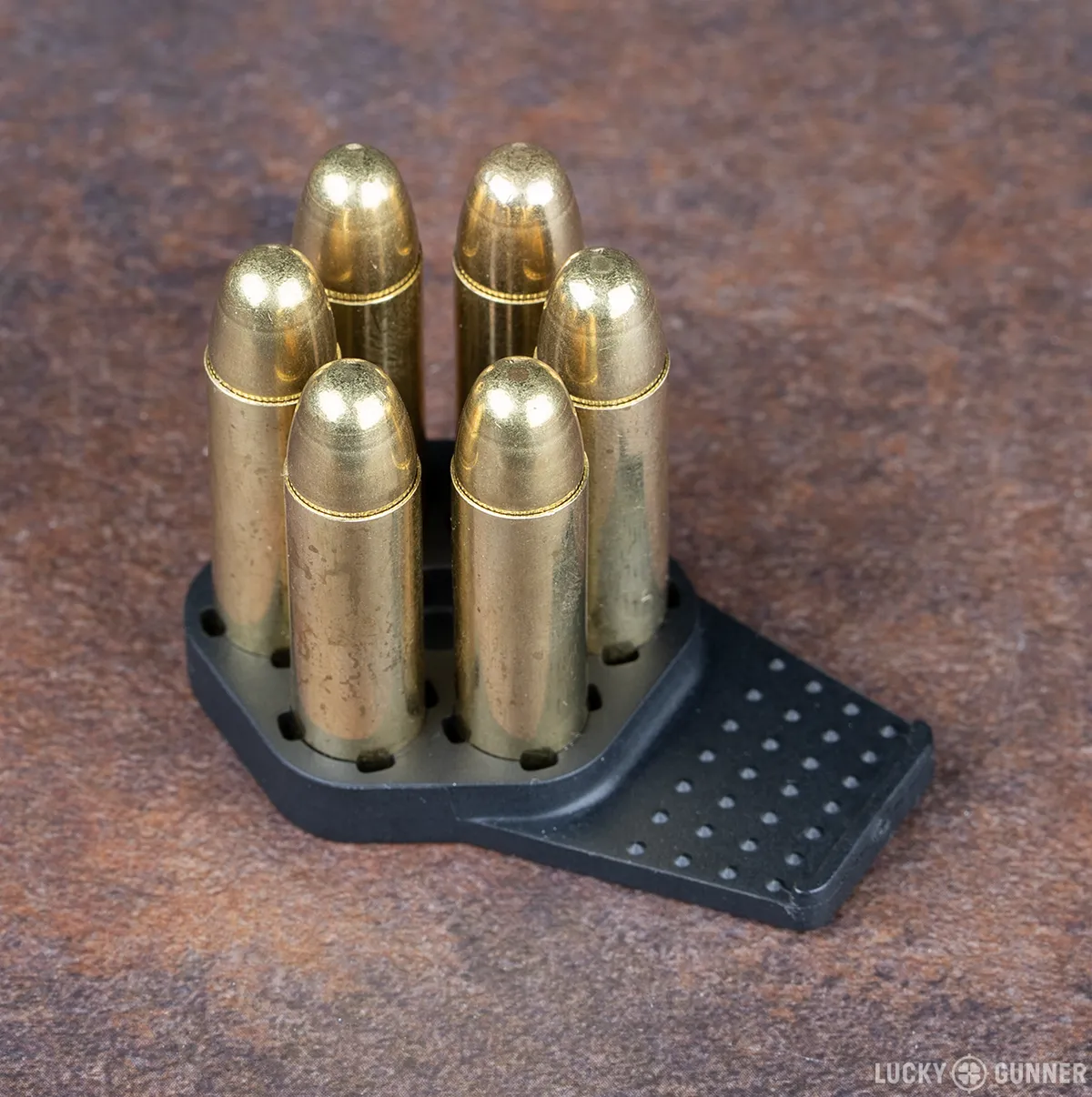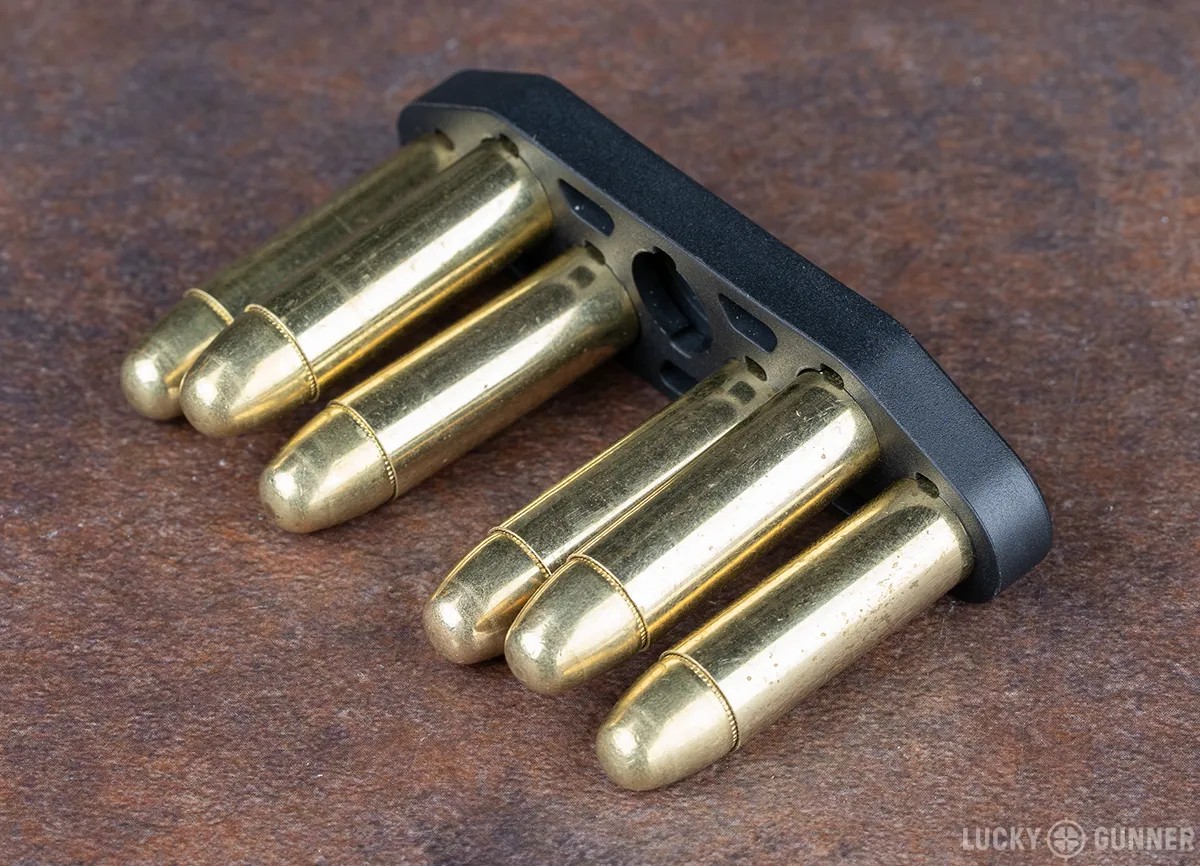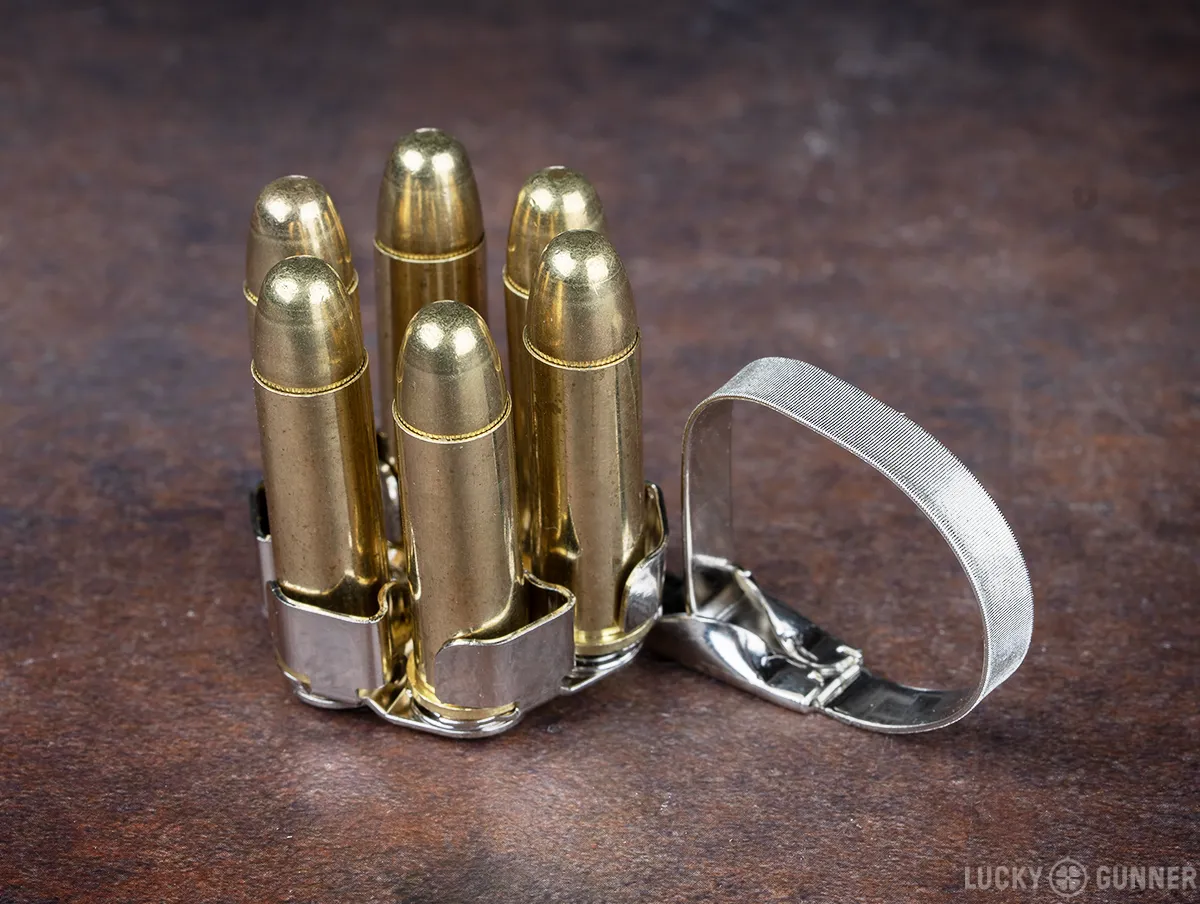Revolver nerds rejoice! I’ve spent some quality range time testing 16 different speedloaders and other reloading devices to see how they compare. From budget-friendly twist loaders to speedy competition models (and some interesting alternatives), I put each one through timed drills so you don’t have to. This isn’t the final word on speedloaders, but if you’re curious about the pros and cons of different reloading options for your wheel gun, this is great place to start.
Details are in the video below, or keep scrolling to read the full transcript.
Hey everybody, I am Chris Baker from Lucky Gunner and today we’re taking a deep dive into revolver speedloaders. I’ve got an overview of 10 different speedloaders that I’ve been testing, plus a look at speed strips, moon clips, and a couple of other loading devices. I’ll go through how each one works, the pros and cons and share my impressions from testing them on the clock.
Like I’ve mentioned many times before – using a speedloader in an actual self-defense situation is pretty much a fantasy. It could happen, but you’d be an outlier among outliers. They’re also bulky and kind of a pain to carry. So why am I spending so much time on speedloaders? Mostly because it’s just fun.
Of course, they’re necessary for action pistol competition. But even if you don’t compete, there’s something satisfying about executing a smooth, fast reload with a revolver.
Testing Procedure
I did a speed test with each of these loaders, but don’t read too much into the numbers. This is a very subjective kind of assessment. I don’t practice revolver reloads regularly anyway, and I’ve only got significant range time with two or three of these loaders. Having said that, I think the numbers do a decent job of showing which loaders are easier to work with and which ones have a steeper learning curve.
I did ten timed reloads with each device. I used a Smith & Wesson Model 64 for every loader that has a K-frame model available. For the two loaders that do not, I used a Model 640 J-frame.
Each loader was deployed from a Safariland speedloader holder. I used the same reloading technique every time. It’s not the quickest possible technique, but it’s the one I can execute most consistently.
General Speedloader Tips
A couple of things to keep in mind when we evaluate these loaders. First, fit is extremely important for speedloaders. The hardest part of the reload is getting the cartridges correctly lined up with the chambers, but it’s a lot easier if the rounds stay fairly rigid in the loader and it’s designed for your specific gun.
Sometimes the manufacturer will claim a loader fits revolvers from multiple manufacturers or product families. It may or may not fit all of those models equally well. You might want to look around for feedback from other users of your specific revolver to find out which loaders fit best.
The revolver’s grips also affect how well speedloaders work. If the grips don’t have enough clearance, the body of the loader might get stuck which can slow the reload or sometimes prevent the loader from working altogether.
And finally, the prices I’ll mention for each loader are the MSRPs. You may be able to find them for less depending on where you shop.
Twist Loaders
Now let’s take a look at these speedloaders, starting with the twist-style loaders. They’re the most common style and they all work more or less the same way.
HKS
The HKS speedloader is probably the most widely recognized with a catalog of 20 different models supporting dozens of different guns.
To load it, place the rounds in the holes, then turn the knob counter-clockwise to hold them in place. When you want to reload, grab the loader by the body, not the knob. Line up the rounds with the chambers and twist the knob clockwise to release them.
Like all the twist style loaders, the HKS relies on gravity. There is no spring to help push the rounds in. So you have to make sure to hold the revolver as vertically as possible when you’re loading. You also might have to pin the cylinder in place so it doesn’t just spin around when you twist the knob.
At just $ 10.99, the HKS is the most affordable of all the speed loaders and widely available.
It had been a while since I last used an HKS loader with a timer and I was surprised at how quick it was. It ended up being the second fastest non-competition loader I tested. They might seem kind of cheap, but if you just need a decent speed loader, HKS is a solid option.
5-Star
The 5-Star speedloaders are similar to the HKS, but they offer an even wider selection with 38 different models supporting dozens of revolvers.
Priced between $ 19.95 and $ 24.95, they’re kind of like the premium alternative to the HKS.
They are all aluminum but they operate the same way as the HKS with one difference. The 5-Stars twist clockwise to load and counterclockwise to release.
The direction you turn the knob would seem to be a pretty insignificant detail, but I found the counterclockwise twist did not feel quite as natural. I’m not sure why. But ultimately, my average speed with the 5-Star was right on par with the HKS.
Pachmayr
Pachmayr offers a more limited selection with just 5 models covering the most common revolvers (but they do get bonus points from me for making a .32 model).
It’s functionally the same design as the other twist loaders. Like the 5-Star, you twist the knob clockwise to load it, and counterclockwise to release.
It’s aluminum with a longer knob than the other two. The rounds rest on top of a rubber gasket inside the loader which makes them feel a little more secure. They don’t rattle around as much. Overall, it just feels like a more serious piece of equipment than the other two twist loaders.
That quality comes at a price: between $ 32.50 and $ 34.98 each.
I ran into an issue with this loader during the speed test. The rounds would not go deep enough into the chambers to release them unless I jiggled the loader a little bit. I got pretty good at doing this after the first couple of runs, so the average time was only a little slower than the 5-Star. But it was an annoying flaw for what is otherwise a very nice loader.
Gravity-Fed Push Loaders
These next speed loaders all have a push to release design. I’ll start with the gravity-release models and then we’ll look at the spring-powered loaders.
Safariland Comp I
The Safariland Comp I is available in just two models – one for 5-shot .38 J-Frames and another for 6-shot .44s.
There are different ways to load these. The way I’ve found easiest is to hold the loader upright. Drop the rounds in. If they jiggle around freely, that usually means they’re seated in there correctly. Then keep holding it perfectly upright while you push the knob up and then turn it clockwise. This can be kind of tricky to do because the knob is not very big. Some people press the rounds against their palm or a table while they twist the knob but that’s never worked that well for me.
The rounds are released from the loader when the post presses against the center pin in the cylinder. So to load with the Comp I, you do not press on the knob. Grip the body of the loader instead, press the whole thing against the cylinder, when you hear the click, the rounds will fall into the chambers.
At $ 21.50, they’re a good value for a loader that’s easy to carry but still reasonably fast.
The grips on our 640 are maybe not the best for speed loaders. They’re slimmer than any of the other grips I have, but there still wasn’t quite enough clearance for a clean release with the Comp I. Honestly, that’s an issue with most J-frame grips. There’s just not much room for speedloaders on these small frame revolvers.
So the numbers I got were not all that impressive, but that could be improved with the right grips.
Safariland Comp II
The Safariland Comp II is the big brother of the Comp I. They make two models, one for K-frames and the other for L-frames.
Loading them is the same as the Comp I except that the knob is much wider and easier to turn. To load the gun, hold the body of the loader, press it against the cylinder and it releases the rounds.
MSRP of the Comp II is $ 21.50, but you can usually find them for about five bucks less.
This is the loader I’ve used more than any of the others. It’s compact but with the potential to be very quick as long as you hold the revolver as vertically as possible. I can drop three or four Comp IIs into each of my front pockets and have a whole box-worth of ammo ready to go on the firing line.
My average speed for these was quicker than any of the other non-competition loaders. That’s at least partly because I have more range time with them. But they’re not difficult to get the hang of. I think they’re the best balance of speed, size, and cost, I just wish they supported a wider range of revolvers.
Revision CV Ammo Pod
The Revision CV Ammo Pod is another gravity-fed speedloader available in four models, all for small-frame revolvers: 5-shot .38s, .22 LR and .22 Magnum LCRs and the NAA Mini-revolvers.
This one has a post with a pin in the middle. Drop the rounds in and then just push the pin until it clicks. The rounds rattle around a bit, but they seem reasonably secure.
To load, just push the body against the cylinder and the rounds drop right in.
At $ 14.95, they’re one of the more affordable options in this category.
Like the Comp I, the Ammo Pod also also didn’t work well with the grips on our J-frame. I had to jiggle the loader almost every time to get it to release the last couple of rounds. The .22 version might be better but otherwise, I’d stick with the Comp I for a J-frame.
Spring Powered Loaders
Okay, now let’s look at the spring-powered loaders. These are the fun ones.
Safariland Comp III
First is the classic Safariland Comp III. It’s available in two models, supporting 6-shot K-Frames and L-Frames.
It’s got a plastic body with a center post attached to this knob and a single big spring. You load it just like the other Comp Models. Drop the rounds in, push the knob in as far as it will go and rotate clockwise. The knob can be a little stubborn. I actually do find it helpful to push the rounds against my palm with this one.
To load the gun, hold the loader by the knob, insert the cartridges and then push the bottom of the knob. That releases the spring, which pushes the rounds in. It is very fast. You don’t have to worry nearly as much about the orientation of the gun. The giant knob makes the loader easy to grab and manipulate.
You probably would not want to carry a Comp III outside of the range. It’s just huge for something that only carries six rounds.
At $ 28.50, they’re more affordable than the other spring-powered options.
The Comp III was the second fastest loader overall in my test. The length has always felt a bit awkward in my hands. I would need more practice to get a consistent release. But overall, they’re very quick and I understand why they’re still a popular option in competition.
Jet Loader
The Jet Loader is available in three models covering .38 J-frames, K-frames, and L-frames.
The design is very similar to the Comp III. The Jet Loader’s knob is not as long and the spring is exposed but otherwise the designs seem nearly identical.
It loads up like the Comp III. Drop in the rounds. Push and twist. And it releases the same too. Insert the rounds and push the knob.
The Jet Loader feels a little more substantial. It holds the rounds a bit more firmly than the Comp III.
They’re priced between $ 39.95 and $ 45.95 depending on the model. That makes them among the more expensive options. What you get for that price is the fastest loader on the market. At least for me.
The size is just right and I found it easier to release than the Comp III. My times with this loader were not only faster than any other, they were also more consistent with just over a second between my quickest and slowest times.
Speed Beez
Speed Beez offers 56 different models covering almost every revolver on the market.
The design is unlike all the others. It’s very similar to the old Dade speedloader from the 70s. The body is polymer with an aluminum knob and a spring-loaded post in the center. The cartridges are held in place by this spring that wraps around the body. When you push the knob, these plungers force the rounds out.
To load it up, all you have to do is just stick the rounds in the holes. The rim slips past the spring and that’s it.
Grab it by the knob, insert the rounds and push to release.
The Speed Beez can be very fast. But there’s a problem with some models. The rounds can kind of splay out in the loader so that they no longer line up with the chambers.
With the K-frame loader, this issue caused very inconsistent performance with nearly three seconds between my fastest and slowest runs.
But I have Speed Beez loaders for other revolvers that don’t have this problem. Like this one for the SP-101 in .327 Magnum. Even though the rounds have some play, they snap back to the correct position. It’ll load with no problem every time.
Another issue with the Speed Beez is that when you drop one, at least some of the rounds will fall out almost every time. If you carry one of these outside of the range, you’ll want to make sure the whole loader is covered and protected.
At $ 42.95 for most models, they’re on the expensive side. But despite the shortcomings and the price, I enjoy using them. When they work, they’re really nice loaders and they’re available for a lot of guns that have very few speedloader alternatives.
SL Variant
The SL Variant speedloader comes in seven models covering the most common .38 frame sizes and six-shot .44 Magnums.
These were originally made in Germany by a company called Longwitz. They have kind of a legendary status – a lot of revolver enthusiasts considered them the best speed loaders ever made.
They stopped production around 8 or 10 years ago. Then in 2022, someone in Japan started selling what they call a “precise replica” of the S.L. Variant. The originals were around $ 60 each but the new ones are between $ 32-35.
They use individual springs for each cartridge. To load it, you simply press the round in until it clicks. Hold it by the body or the knob and press to release.
There’s an extended competition style knob available that screws right on to the original knob.
I had some of the original S.L. Variants and unfortunately, these are a sad imitation. The originals were adjustable. You could push in the center post and rotate it to fine tune the angle of the rounds. The new ones are not adjustable. The bigger issue is that the rounds don’t stay correctly aligned. The S.L. Variant is the only loader I used where I had this happen – and it happened more than once.
When the rounds did happen to line up, the release was very clean. But the alignment problem made this the slowest of the K-frame loaders.
I did another ten runs with the extended knob installed. That did make it a little easier to get the rounds aligned and my times definitely improved. It was still quite a bit slower than the Comp III or the Jet Loader.
I did buy these over three years ago, so there’s a chance the newer ones are better. But if not, there’s no way I can recommend the replica S.L. Variant.
Other Loading Devices
Okay, that’s it for what we’d traditionally call speed loaders, but let’s look at some other loading devices. We’ll start with moon clips.
Moon Clips
Moon clips are essentially thin pieces of sheet metal specifically designed to hold revolver cartridges together in a circular pattern.
You drop the entire unit – both clips and cartridges – into the cylinder, and they remain there during firing.
This makes moon clips generally the fastest method of reloading a revolver. Ejection is also much more consistent since all the spent shells are linked together and eject as a unit.
Revolvers designed to fire semi-auto cartridges (like 9mm or .45 ACP) almost always require moon clips because they lack the rim for the extractor star to grab onto. Rimmed revolver cartridges don’t need moon clips, but the cylinder can usually be modified to accept them.
So if moon clips are the fastest reload method, why don’t all revolvers use them? The main reason is their lack of durability. Moon clips are notoriously fragile. They can be easily bent during handling, carrying, or even just loading and unloading them. Even a barely perceptible bend can cause the cylinder to bind or prevent it from closing. They can also be picky about ammunition. Small variations in rim thickness can cause issues.
The only moon clip revolver I had handy for our test was a 9mm LCR. It’s not the ideal example because small frame revolvers are inherently a little slower to reload. Even with this limitation, my moon clip reloads were very quick. Only the Jet Loader and Comp III performed better.
Moon clips really shine in competition, where the extra speed can make a difference and the fragility is less of an issue. Outside of the range, moon clip revolvers are fine if they’re already loaded, but if you carry spare loaded moon clips for reloads, they need to be very well protected.
Speed Strips
Speed strips might be the most common way to carry spare revolver ammo, despite being notably slower than other reloading methods.
Technically, the name “Speed Strip” refers to the original Bianchi product but we tend to use the term for any similar devices. They’re all very inexpensive – they usually come in a 2-pack for $ 10 to $ 15.
Most are designed for five and six-shot .38s, except Tuff Products QuickStrips, which come in at least 19 models for everything from .22 LR to 12 gauge shotgun shells, with various length options.
Speed strips are made with different types of flexible polymer or rubber. Just pop the rounds into the recesses. To load, you insert the rounds one or two at a time and peel the speed strip away.
I like QuickStrips because I can use the 8-shot model with only six rounds. Leaving spaces between cartridge pairs makes them easier to load. A lot of revolver guys use the same approach with 5-shot strips loaded with four rounds. The Zeta-6 J-strip already incorporates these spaces into the design.
A drawback of QuickStrips is that they tend to deform after repeated use. The first pair of cartridges often splay outward, which slowed down some of my reloads a bit.
In my testing, the speed strip pocket reload was predictably the overall slowest method by far. I also tried loading just two rounds with the J-strip. It was faster, but I burned a lot of time indexing the cylinder so it was still pretty slow.
Speed strips are popular because they’re extremely flat and pocket-friendly. They’re slow, but much quicker than loading loose rounds from a pocket or dump pouch. And they’re just a convenient way to transport ammo.
Zeta-6 Loaders
Zeta-6 has a couple of other interesting loading devices that are kind of in the speed strip family, but they’re also unique.
The K-clip and J-clip are basically speed strips but in a circular pattern.
It turned out to be a lot quicker than I thought it would. It’s certainly more compact than any speed loader. The biggest issue I had with it was that sometimes one or two of the rounds would come out of the cylinder when I peeled away the K-clip. You have to yank on this thing pretty hard to get it to release the rounds.
The Zeta-6 K-Pak is a double-decker speed strip that allows you to load three rounds at a time.
There are different ways to configure it depending on your preference and what hand you’re loading with. I’m not sure I was using the quickest method. It was not a ton faster than the Quickstrip, but it was more consistent. This might be worth considering as an upgrade over a traditional speed strip that’s still very flat and easy to carry.
Wrapid Loader
Okay, the last loading device I want to look at today is the Wrapid Loader.
For $ 49.99 you get an all-steel loader and a leather carrying case.
It consists of six spring-loaded cartridge holders linked together. When you let go of it, they coil into a ball that is roughly the diameter of a K-frame cylinder. To load it, you have to unroll it and hold it open while you slide each cartridge in.
The case holds the device flat so you can carry it. To deploy it, you grab the ring and pull it from the case (you have to use your left hand for this). Insert the cartridges – this is the tricky part. Once they’re in there, pull the ring to release the rounds.
There’s a polymer loader called the CK Tactical Ripcord that works on a similar principle. And it’s based on a design from the 1970s. So the Wrapid Loader is a new take on an old concept.
I tried timing a couple of reloads, but it quickly became clear I would need to invest a lot of time practicing with it just to reach basic competence. It’s finicky to load and overall just kind of frustrating. I like the creativity but I’m not sure it’s all that practical.
Conclusion
If you want a solid second opinion on some of these loaders, check out the Revolver Guy Blog. A few years ago, Justin did a similar speed loader test but with even more detail if you can believe that.
After all of this testing, I’m sticking with the Comp II as the best all-around speedloader. The other standouts are the HKS for a surprisingly good bargain. The Speed Beez are great just because they support almost every revolver ever made. And the Jet Loaders win for pure speed.
But to be honest, if you really want ammo delivered as quickly as possible… you should get it from us with lightning fast shipping at Lucky Gunner.
The post The Ultimate Revolver Speedloader Showdown: 16 Loading Devices Tested appeared first on Lucky Gunner Lounge.
